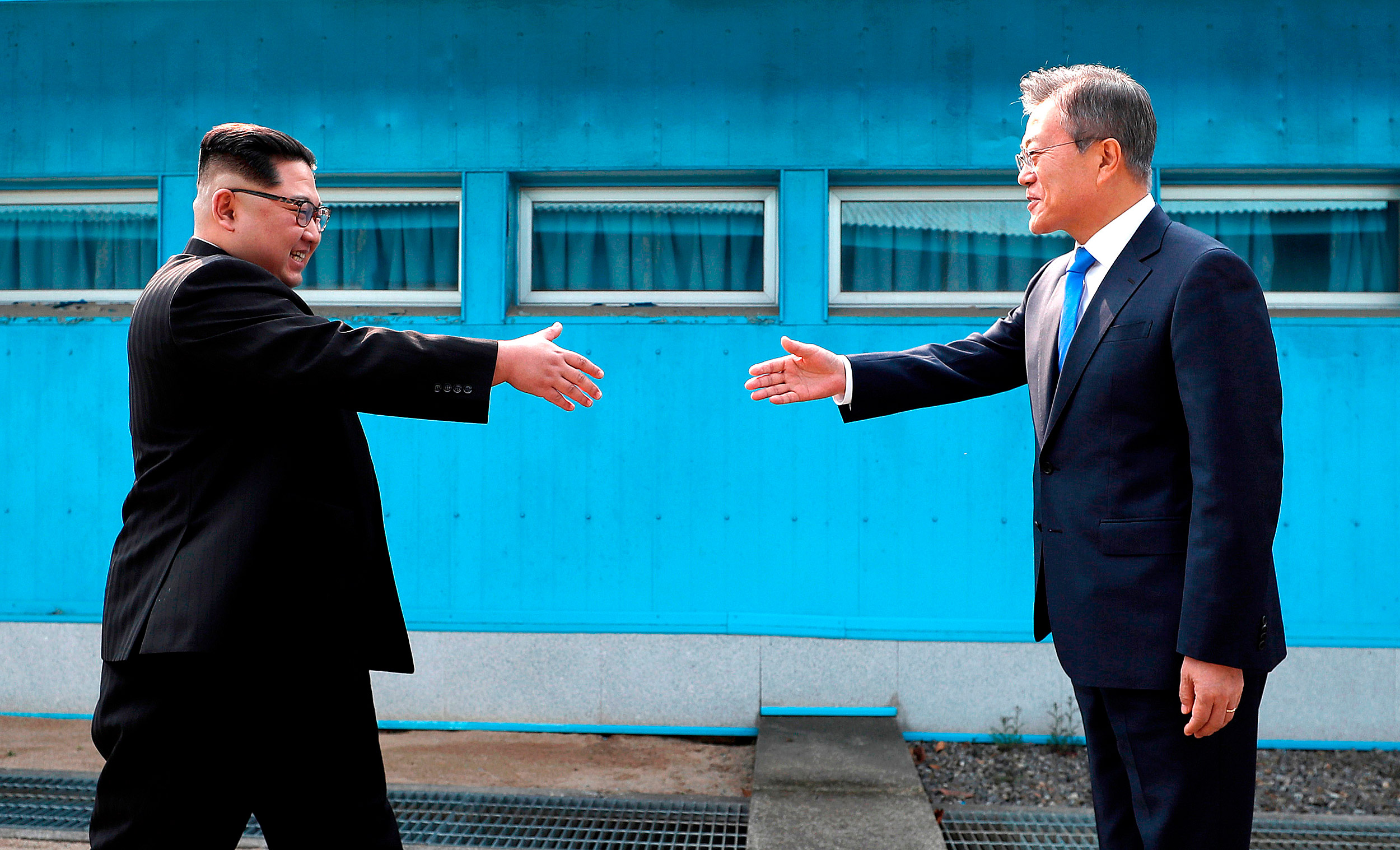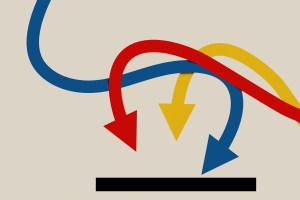
Following the historic announcement of their intent to sign a peace treaty, the Gazette talked to the Belfer Center’s John Park to discuss the prospects for lasting peace between North and South Korea.
Credit: Korea Summit Press Pool via AP
A historic summit, with uncertain outcome
Belfer Center expert looks at potential progress, fallout from the North, South Korea meeting
South Korea and North Korea may be on the verge of a historic accord that would end 65 years of conflict and division between the two nations. President Moon Jae-in of South Korea and Kim Jong-un of North Korea stunned the world by announcing their intent to formally end the Korean War later this year and rid the Korean peninsula of nuclear weapons. Though neither offered specifics on how or when they might accomplish this feat, a lasting truce could have transformative geopolitical implications for Asia, the U.S., and the world.
It’s a shoot-the-moon goal that would have been unimaginable less than two years ago when Kim, who of late had dramatically escalated his rhetoric and taunted the world with demonstrations of North Korea’s nuclear capabilities, used a model of South Korea’s presidential residence, the Blue House, as a target during a nuclear operational drill.
John S. Park is director of the Korea Working Group at the Harvard Kennedy School’s Belfer Center for Science and International Affairs. He spoke with the Gazette about what’s driving the talks, the likely outcome of this possible accord, and what both sides will have to overcome to make the results into reality.
Q&A
John Park
GAZETTE: As someone who’s spent many years studying this region, were you surprised by this announcement?
PARK: I think the Panmunjom Declaration is very consistent with previous inter-Korean agreements. These landmark agreements have similar language, so I think it more fits a pattern rather than being an outlier. However, after the elevated tensions last year resulting from North Korea’s nuclear and intercontinental ballistic missile testing, the Panmunjom Declaration is a particularly welcome development.
GAZETTE: Why now?
PARK: There’s a big debate about why now. At the core of that debate is whether Chairman Kim Jong-un agreed to the summit meetings out of a position of weakness (i.e., sanctions biting hard) or strength (advanced nuclear weapons development). I argue that Kim did so out of a sense of unique opportunity to explore what South Korean and American leaders are prepared to offer for denuclearization. President Moon Jae-in assumed most of the risk by investing a lot of South Korea’s political capital to accelerate the momentum for a diplomatic off-ramp with the summit.
GAZETTE: So it was South Korea’s efforts that really moved the ball here?
PARK: Seeing how dangerous the situation became on the Korean Peninsula last year, with an elevated risk of military conflict, President Moon acted swiftly in deploying South Korea’s political capital. The game plan began with arranging North Korea’s participation in the PyeongChang Winter Olympics, quickly followed by a senior South Korean delegation’s meeting with Chairman Kim in Pyongyang. That was followed by the South Korean national security adviser’s meeting with President Trump in the Oval Office, where he agreed to a summit with Chairman Kim.
GAZETTE: Is this a legitimate diplomatic breakthrough, or merely for show?
PARK: It has to be viewed through the perspective of a process. The notion of tackling these very contentious issues, moving from an armistice to a peace treaty and also from the current state of nuclear weapons development in North Korea to denuclearization on the Korean Peninsula — all of these things are incredibly complex. But we’re looking at it from the perspective now of what kind of process can be put in place so that these difficult issues can be resolved in a way that can meet the security needs of all of the countries involved.
GAZETTE: What will you be looking for to see whether this is more than just a splashy event from the summit?
PARK: This is just the beginning. Whether it’s a short-lived process or something that gains momentum remains to be seen. However, we have a planned U.S.-North Korea summit coming up next. I think from what’s been agreed to in the inter-Korean context, more on the side of principles and goals and aspirations, we now have a nascent foundation on which the U.S. and North Korean leaders can get into more of the details on what a denuclearization mechanism may look like.
GAZETTE: What is Kim expecting to get out of this?
PARK: I think broadly it’s the idea that his regime can focus on longer-term economic development. This is why we have to manage expectations. It’s not going to be a function of North Korea giving up the nuclear weapons all at once, but rather, as part of a process. And this is where the timescale becomes a big focus of the diplomacy and negotiations ahead. From a North Korean perspective, the longer the process, the better it is for them. But from the U.S. perspective, given the rapid development of nuclear, and particularly the intercontinental ballistic missile capability last year, the timescale is much shorter. So the big focus of the process ahead is on the interim steps. But the idea that the countries are actually looking for a package deal is the positive beginning point here.
GAZETTE: What are the most important, substantive elements of this agreement that have not been part of past talks?
PARK: What’s new in the Panmunjom Declaration is North Korea’s level of nuclear weapons development. July of last year was an important threshold that they passed, and that was the ability to range the American homeland with intercontinental ballistic missiles. North Korea is still at the earlier stages of the development of that capability, but they have entered this dangerous ballpark. We have had previous summits, we’ve had previous inter-Korean dialogues and agreements related to the denuclearization, and, frankly, we’ve had multilateral deals as well. What’s different now is that if diplomacy collapses, there’s a real possibility that we could go back to the elevated tensions of last year.
GAZETTE: So what’s pushing them to the table now is that they’re within U.S. range?
PARK: The stakes are higher for Washington. It’s the U.S. position that North Korea has to give up its nuclear weapons, and there are two ways they can do it: through negotiations or through the use of force. This is something we haven’t seen before. In the past, the U.S. supported diplomatic activities, but when talks collapsed, [you] just went into a dormant phase as opposed to this idea of elevated tensions with the increased possibility of conflict. This cycle could be dramatically different if we do see the collapse of diplomacy this time.
GAZETTE: The pledge is for a treaty to end the Korean War. But after that, what’s the end goal? Is it premature to think that there will be a unified Korean Peninsula in the not-too-distant future?
PARK: I think reunification actually becomes something that’s pushed further away. If they move to a peace treaty, there will be peaceful coexistence, and maybe more economic development and advanced joint activities in terms of overall economic opportunities for their respective people.
GAZETTE: Is there any reason to trust that North Korea will denuclearize given its track record, and how will that be addressed?
PARK: The parties all around mistrust each other, so that’s a perennial challenge. The bar is higher now. The U.S seeks irreversible denuclearization for economic development and security concessions to North Korea. Transforming the demilitarized zone into a peace zone is certainly positive, but the big question is the timeline of denuclearization. Everyone is cautiously optimistic. Launching a denuclearization mechanism is a critical initial step. The subsequent steps are much more complex — verification and inspection actions.
GAZETTE: How might the Panmunjom Declaration affect the U.S.-North Korea summit? Does it blunt the import of that meeting? And conversely, how does the U.S.-North Korea summit potentially threaten to introduce a third wheel that could disrupt the accord?
PARK: The hope is that the momentum created by the inter-Korean summit will carry over into the U.S.-North Korea summit. A positive practice taking place is close coordination and consultation on a bilateral basis between Moon and Kim, as well as Moon and Trump. In mid-May we’ll see President Moon go to Washington to debrief President Trump about what happened at the inter-Korean summit. I think that’s going to be another opportunity to try to do some more planning on what could take place at the U.S.-North Korea summit.
GAZETTE: Beyond the timeline expectations, what are some of the likely hurdles to such a treaty and, presumably, a rapprochement between the two Koreas, and how do they realistically overcome them?
PARK: North Korea is expecting sanctions relief. The U.S. opening statement is that lifting sanctions is directly tied to North Korea giving up its nuclear weapons program. However, for other countries, there’s more wiggle room since diplomacy is gaining steam — China is reported to have already eased up on sanctions implementation.
This interview has been edited for length and clarity.




